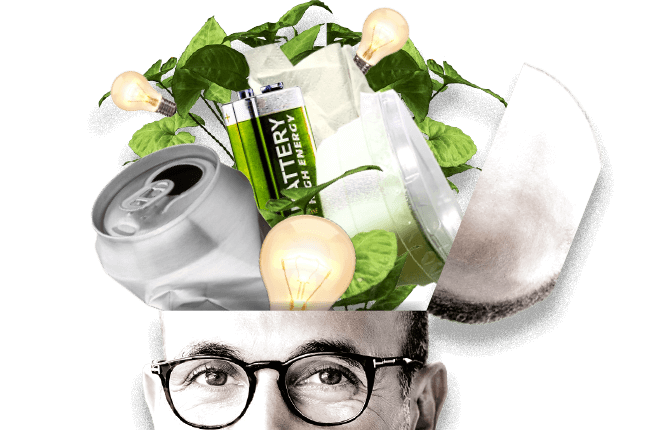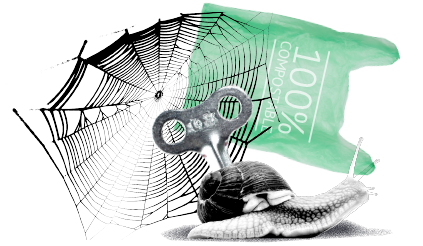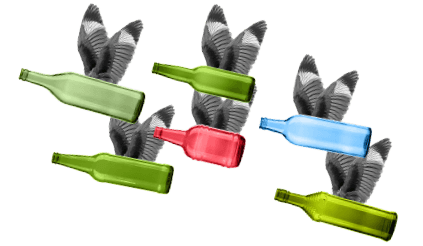Read about the old bottle myth, that claims all the different coloured bottles end up on one single pile
Suche
REMONDIS’ business locations around the world
Being one of the leading recycling, service and water companies, REMONDIS has approximately 1,000 business locations around the globe. These can be found in over 30 countries across Europe, Africa, Asia and Australia.
REMONDIS’ business locations in Germany
REMONDIS’ business operations in Germany are managed by six regional companies. Moreover, a whole variety of specialist REMONDIS companies are based here in Germany as well.
It’s not like at school here. Telling others the right answer is good
No matter how practical and clear our wheelie bin ABC may be, it is what it says it is: an ABC. It simply covers the basics and there will always be situations that are more complicated. Our customers often get in touch with us to ask about those trickier cases. Which is why we’ve explained them below. Don’t worry. It’s much less baffling than you may think. The same is true as with so many other things in life: it’s quite simple once you know how.

Lithium-ion batteries – Mini power stations at risk of suffering a meltdown
Lithium-ion batteries (aka Li batteries) have become part of our everyday lives. They can be found everywhere – in cordless power tools such as drills and screwdrivers as well as in e-bikes.
Lithium-ion batteries can always be handed back to the shop where you bought the electrical/electronic device that they were in. For example, to the e-bike shop or electrical store. Local household waste recycling centres also accept Li batteries. Be careful not to damage the battery during transport and stick some sticky tape over the battery pins/terminals to prevent them touching something they shouldn’t – this stops it short circuiting.
Lithium-ion batteries can even self-ignite – especially if they’re misshapen or otherwise damaged. In some cases, they may even explode. Which is why you should never store old Li batteries in your home but take them to a dedicated collection point straight away.

Yoghurt pots – A source of vitamins and, ideally, raw materials
Eating yoghurt is good for your health. Unfortunately, the way some people dispose of their yoghurt pots is not good for the environment. For the most part, the pot and its lid are made of plastic and aluminium. Two materials that have a negative impact on resource conservation and our climate when they are produced using virgin raw materials. Which makes it all the more important that they are separated from each other so they can be recycled according to type.
Take the lid off the pot and then throw them both into the yellow bin or recycling bin. If possible, scrape any remaining yoghurt out of the pot and off the lid. There’s no need to wash them. Empty pots should never be stacked one inside the other. This makes it difficult for the machines to pick them out in the sorting plants
Would you have guessed it? The biggest enemy of recycling is people putting their used products into the wrong bins. Why? Because this contaminates the recyclable materials. Find out more in the section professional recycling know-how

Coffee pods – the general waste bin is the wrong choice
Is it perhaps the ‘George Clooney effect’? Whatever the reason, single-use coffee pods are becoming ever more popular. At the moment, they’re never going to win an Oscar for sustainability though. The reason for this has more to do with the way they are disposed of rather than the coffee pod per se. A large number of the used coffee pods found in Germany end up in the general waste bin – which means they’re not recycled and the materials are lost to us forever.
Coffee pods are made of aluminium – a valuable material that is easy to recycle. Which means they belong in the yellow bin or recycling bin. You can take the coffee grounds out of the pods beforehand and put them in the organic waste bin. By the way: don’t be fooled if your coffee pod has a ‘biodegradable’ sticker. The actual capsules must never be thrown into the food and garden waste bin.
Coffee pods are an excellent example of why the yellow bin is a problem. From a purely legislative point of view, coffee pods are not ‘licensed packaging material’ and should be put in the general waste bin. This makes absolutely no sense when it comes curbing climate change and conserving natural resources. Why? Because the pods are incinerated and not recycled when they’re put in the general waste bin.


Biodegradable and compostable packaging – A bit of a sham
More and more biodegradable and compostable bags and packaging materials are being used in Germany. There’s a big problem here, though: they are not as sustainable as they claim to be. In fact, studies have revealed that their environmental footprint is, in some cases, worse than standard plastic products. Compostable bags – made, for example, from sugar, lactic acid or cellulose – take so long to rot and degrade that a composting plant is most definitely not the right place for them.
Biodegradable and compostable packaging materials and bags should be thrown away into the yellow bin or recycling bin just like standard plastic packaging. Even the biodegradable bags displaying the seed symbol – which means they should be suitable for food and garden waste bins – are banned by most councils. So please put them in your yellow bin or recycling bin. Obviously without the food waste that was in them.
The difference between biodegradable and compostable packaging materials is that the former can be made using oil-based raw materials while the latter must be produced from organic elements. Both are a problem for recyclers. Biodegradable bags and packaging materials break down into dangerous microplastic that – if it ends up in a composting plant – contaminates the fertiliser produced by the plant. Compostable bags have a further disadvantage besides needing such a long time to rot: the organic raw materials required to make these bags often come from monocultures, which also damage our environment.
Old bottles – when in doubt, the sign’s always green
There are over 250,000 bottle banks in Germany. One question is often asked despite there being so many: ‘Aren’t there some missing?’ The only bottle banks around are for clear, green and brown glass. Shouldn’t there be some for the other bottles? No, that’s not necessary. Find out why here.
There’s absolutely no need to feel guilty about putting your glass bottles into the bottle bank for green glass if they’re not made of clear, green or brown glass. A bit of background info: when melted down, green glass is the least affected by other types of coloured glass. Where possible, please remove the caps before throwing the bottles away – i.e. unscrew them and put them in your yellow bin or recycling bin. The paper labels can stay on the bottle. You don’t need to wash them out either; that simply consumes water. It’s more than enough to simply remove as much of the content as possible from the jars.
Bottle banks should only be used for disposing of glass packaging such as jam jars, bottles and perfume bottles. All other types of old glass – for example, crystal glassware, drinking glasses, window panes and mirrors – should not be put in them. Why? Because they sometimes have a higher melting point and cannot be recycled by glass processing plants.

Aerosol cans – a waste that can pack a punch

The days when aerosol cans contained climate-damaging CFCs are long gone. Despite this though, used deodorant cans, hairspray cans and other such aerosols still need to be disposed of very carefully. On the one hand, because they contain a highly flammable propellant – normally butane – and, on the other, because any contents left in the aerosol pose a risk.
As aerosol cans are made of metal and plastic, they are in principle able to be recycled and should be put in the yellow bin or recycling bin. This, though, is only true for aerosol cans that are absolutely empty. Aerosol cans that still have some of their contents left in them are classified as hazardous waste. This means that they must be taken to your local household waste recycling centre or handed in to your mobile hazardous waste collection service. To find out where these are, simply take a look at the website of your local council or your local waste management firm.
Aerosol cans that are not completely empty and that are thrown into a kerbside bin for collection poses a risk to both humans and the environment. Extreme heat or other external factors can cause them to catch fire or explode. By the way, REMONDIS has developed a special collection scheme called RESPRAY for its commercial customers that enables empty and partly filled aerosol cans to be stored, transported and recycled safely. This scheme not only recovers the aluminium and tinplate from the cans for reuse but also recycles the aerosols’ propellants.
Nappies –a person’s environmental butt print

No matter how much we want to be sustainable and try to conserve natural resources as an adult, we are still weighed down by the environmental footprint of when we were a baby. During the first few years of their life, an infant uses approx. 5,000 disposable nappies – a total weight of almost precisely one tonne.
Used disposable nappies obviously belong in the general waste bin – well packed in a bag tied with a tight knot to prevent unpleasant smells.
People who throw single-use nappies into their yellow bin or recycling bin instead of their general waste bin are doing their local waste management firm a huge disservice – and resource conservation as well. Why? Because it means that all of the contents of the bin can no longer be recycled.
An alternative to incineration: REMONDIS operates a pilot plant in the Netherlands that is dedicated to recycling nappies

Cash register receipts – a tricky take-away problem
There was a huge outcry from retailers and consumers in 2020 when it became obligatory for shops to print out their cash register receipts. One of the biggest reasons for people to shout about, though, was the impact this statutory amendment had on the environment. This change meant that a further 5.7 million kilogrammes of waste are being generated every year – a waste that is more difficult to dispose of than many may think because of the thermal paper used to make the till rolls.
Cash register receipts printed on thermal paper should be thrown into your general waste bin – not into your paper recycling bin. The coated paper contains chemicals and these would end up in the recycled paper.
Thermal paper is used to make cash register receipts because it is a better material to print on and unwinds more easily. Faced with the fact that this paper cannot be recycled, this is an expensive price to pay. And then there is the additional problem that some of the chemicals used to coat the paper – first and foremost the dye developer bisphenol S – are believed to be a possible health risk.

Face masks and single-use gloves – Stopping bacteria and viruses in their tracks

Normally, the recyclability of a product depends on what material it is made of. There are a few exceptions to this, however, when priority is put on what the product is used for. Face masks and single-use gloves are one of these exceptions – as is all medical waste. What is most important here is ensuring they are disposed of hygienically.
Face masks and single-use gloves – no matter what type of plastic they are made of – must always be thrown into your general waste bin. By doing so, you’re making sure that the material is incinerated and made safe.
Even if the question of hygiene were to be put to one side, single-use gloves are not suitable for recycling anyway. They are made of latex, vinyl or nitrile – none of which can be recycled. The same is true for face masks. They are made of fleece that has, in many cases, been mixed with plastic fibres such as polypropylene. This is, therefore, a composite material that must not be thrown into the paper recycling bin or the yellow bin.





